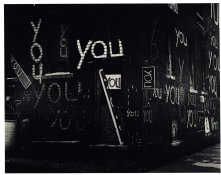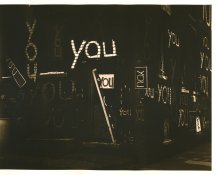So I was really unhappy with the state of homebrew lith developers, especially since Easylith isn't cheap and most others contain formaldehyde. I wanted a lith developer part A that contains little sulfite, is minimally acidic (ie, doesn't require a lot of part B to neutralize), and is shelf stable for at least several months, even if tray life isn't great. I stumbled into mixing hydroquinone with triethanolamine in order to make an ideal lith developer that is shelf stable, and contains literally nothing else and thus completely open for customizing with different ratios of sulfite etc.
My recipe is super simple:
* TEA - 300ml
* HQ - 60g
Heat to at least 170F/76C and mix to combine, 190F/88C makes mixing easier. Keep in mind that TEA is flammable. The autoignition temperature is ~250C but I see no need to bring the temperature above 100C. The HQ may reduce the temperature and require more heating. There may be air bubbles which resemble crystals, but if they try to float to the top with no stirring then you know it's just air. Note that this will increase the volume of the solution to around 350ml. If using an exact bottle size, keep this in mind. Final solution will progress from a bright yellow to a slightly darker orangeish-yellow.
More HQ could be dissolved in the TEA, but at that point it gets kinda difficult to measure with a graduate. Anyway, so this is literally just HQ in an alkaline syrup. No water is present and in theory it should last practically forever despite containing no preservatives, similar to HC-110. Using a lith developer like this requires several more "parts" because HQ and alkali alone are not stable once you introduce water.
I recommend keeping on hand:
* 10% solution of sodium sulfite
* 10% solution of potassium bromide
* 10% solution of potassium/sodium carbonate OR 1% solution of sodium hydroxide
* 1% solution of citric acid (acetic acid or some other stable acid should work too, I just prefer non-smelly)
* syringe capable of measuring less than 10ml
* graduate for measuring 5-50ml
A starting point mix is the following:
* 1L of water
* 15ml of HQ-TEA
* 10-30ml of 10% sulfite
* 5-20ml of 10% bromide
This should work and may be a bit fast depending on paper choice. TEA has a pH of around 10-11.2 depending on dilution, so add some acid if the activity is too high as if you had added too much part B with standard lith developers. If using yellow technical grade TEA, it can have a pH of up to 12, so a starting point mix would probably require something to bring down the pH.
General notes:
* Some papers show excessive snowball type effects in shadows and blacks, increase sulfite for this.
* Some papers *may* (unconfirmed) react with even a weak solution of TEA+bromide and cause fogging and/or degredation of dmax and speed. This is learned from my research of "PFS-4", but unsure it applies with developing agents and sulfite present.
* If the developer has a distinct red film on it especially near tray edges, do NOT attempt to process anything else until adding enough sulfite to dissolve the red film and 2-6ml more sulfite so that it keeps working for each print, usually around 6ml total. If you live on the edge with this developer always being almost dead, plan on adding 2-10ml of sulfite after each print, especially if a lot of blacks are present in the image being printed.
* you can print with no sulfite present, but the results will be terrible, low contrast, and with no infectious development. Some amount of sulfite is required and consumed by infectious development.
* When the developer is right on the edge of dying and you can see a film moving around on the print in development under safelights, you can move the print to a water tray, add some sulfite to the developer, mix it up, and put the print back in
* If there is not enough sulfite, along with slower development action, you can get fogging on edges that looks like blur/out of focus, and will get low contrast without proper infectious developed blacks.
* This will work fine with no additional alkali in my experience and TEA seems to be a much more stable pH buffer than carbonate/hydroxide. If you prefer less color or faster times, you can add some alkali though.
* If using minimal sulfite your developer will die.. a lot. It can be revived with sulfite usually, but it does seem to easily just get overloaded with restrainers from printing after ~15 prints. The developer isn't truly dead until it's brown and sulfite does nothing to the color.
* I've tried replenishment (HQ-TEA+sulfite) after true developer death, but it didn't go well. Needs more testing probably
* This seems to be a cooler tone lith developer than most other lith developers. One paper type (Kodabrome) which typically prints out to peach and warm orange tones, printed out to green shadows and peach highlights. Another paper type (Polymax) which typically prints out neutral instead printed out with with cool blacks and subtle lilac highlights. This is probably due to both TEA having some side-effect, and the lack of formaldehyde and relatively low sulfite content.
My recipe is super simple:
* TEA - 300ml
* HQ - 60g
Heat to at least 170F/76C and mix to combine, 190F/88C makes mixing easier. Keep in mind that TEA is flammable. The autoignition temperature is ~250C but I see no need to bring the temperature above 100C. The HQ may reduce the temperature and require more heating. There may be air bubbles which resemble crystals, but if they try to float to the top with no stirring then you know it's just air. Note that this will increase the volume of the solution to around 350ml. If using an exact bottle size, keep this in mind. Final solution will progress from a bright yellow to a slightly darker orangeish-yellow.
More HQ could be dissolved in the TEA, but at that point it gets kinda difficult to measure with a graduate. Anyway, so this is literally just HQ in an alkaline syrup. No water is present and in theory it should last practically forever despite containing no preservatives, similar to HC-110. Using a lith developer like this requires several more "parts" because HQ and alkali alone are not stable once you introduce water.
I recommend keeping on hand:
* 10% solution of sodium sulfite
* 10% solution of potassium bromide
* 10% solution of potassium/sodium carbonate OR 1% solution of sodium hydroxide
* 1% solution of citric acid (acetic acid or some other stable acid should work too, I just prefer non-smelly)
* syringe capable of measuring less than 10ml
* graduate for measuring 5-50ml
A starting point mix is the following:
* 1L of water
* 15ml of HQ-TEA
* 10-30ml of 10% sulfite
* 5-20ml of 10% bromide
This should work and may be a bit fast depending on paper choice. TEA has a pH of around 10-11.2 depending on dilution, so add some acid if the activity is too high as if you had added too much part B with standard lith developers. If using yellow technical grade TEA, it can have a pH of up to 12, so a starting point mix would probably require something to bring down the pH.
General notes:
* Some papers show excessive snowball type effects in shadows and blacks, increase sulfite for this.
* Some papers *may* (unconfirmed) react with even a weak solution of TEA+bromide and cause fogging and/or degredation of dmax and speed. This is learned from my research of "PFS-4", but unsure it applies with developing agents and sulfite present.
* If the developer has a distinct red film on it especially near tray edges, do NOT attempt to process anything else until adding enough sulfite to dissolve the red film and 2-6ml more sulfite so that it keeps working for each print, usually around 6ml total. If you live on the edge with this developer always being almost dead, plan on adding 2-10ml of sulfite after each print, especially if a lot of blacks are present in the image being printed.
* you can print with no sulfite present, but the results will be terrible, low contrast, and with no infectious development. Some amount of sulfite is required and consumed by infectious development.
* When the developer is right on the edge of dying and you can see a film moving around on the print in development under safelights, you can move the print to a water tray, add some sulfite to the developer, mix it up, and put the print back in
* If there is not enough sulfite, along with slower development action, you can get fogging on edges that looks like blur/out of focus, and will get low contrast without proper infectious developed blacks.
* This will work fine with no additional alkali in my experience and TEA seems to be a much more stable pH buffer than carbonate/hydroxide. If you prefer less color or faster times, you can add some alkali though.
* If using minimal sulfite your developer will die.. a lot. It can be revived with sulfite usually, but it does seem to easily just get overloaded with restrainers from printing after ~15 prints. The developer isn't truly dead until it's brown and sulfite does nothing to the color.
* I've tried replenishment (HQ-TEA+sulfite) after true developer death, but it didn't go well. Needs more testing probably
* This seems to be a cooler tone lith developer than most other lith developers. One paper type (Kodabrome) which typically prints out to peach and warm orange tones, printed out to green shadows and peach highlights. Another paper type (Polymax) which typically prints out neutral instead printed out with with cool blacks and subtle lilac highlights. This is probably due to both TEA having some side-effect, and the lack of formaldehyde and relatively low sulfite content.
Last edited:







